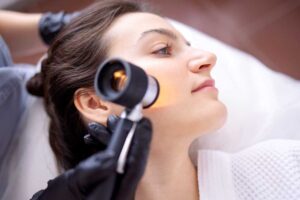The lateral lid-cheek junction or medial cheek is a good injection site for restoration. Yet, it can easily become overtreated and could result in bumps and irregularities. So, is there a technique? Yes. Proper execution requires mapping key anatomical landmarks, including arteries like the infraorbital and angular arteries. The results? It will help you avoid vascular complications.
Pro Tip: We suggest using a thinner dermal filler product at this stage, with its bevel facing down towards the periosteum for easy injection.
Purpose of Filler Injection Techniques
So, why do we have all these different techniques in the first place? Simple. Filler injections in the medial cheek are all about restoring what time takes away. As we age, deep medial cheek fat shifts downward, volume loss occurs, and the cheeks start to look hollow or tired. So, you can get the same youthful appearance once again.
But here’s the catch: this area sits close to important blood vessels and nerves. So, precision really matters. The safest way to inject here is by slowly placing filler as the needle or cannula is pulled back. This helps reduce the risk of hitting anything you don’t want to.
Cheek Filler & Facial Anatomy
It’s important to know what’s underneath the skin. The cheeks aren’t just soft padding. They’re made of fat layers, the orbicularis oculi muscle, tiny blood vessels, and nerves.
One key layer is called the SMAS (superficial musculoaponeurotic system). Yes, it’s a mouthful. Think of it like a sheet that holds together the whole face. Injecting filler directly into or above this layer can put pressure on those delicate structures, which is why skilled injectors carefully map out where to place the product.
Another point to understand: the muscles in this area sit very close to the bone, without much protective padding. That means that if a needle moves in the wrong direction, it can damage a vessel inside the muscle. To avoid that, the injector uses careful, slow movements and stops pushing forward once they feel resistance.
Safety for Anterior Cheek Injection
While most treatments are done without any problems, this one can lead to serious complications. These range from poor cosmetic results (such as unevenness or lumps) to more severe issues, including vision problems.
The reason the risk is higher here is that the facial arteries are especially delicate. They’re small, twisty, and have skinny walls. So, they are easier to block if too much filler is injected in the wrong spot. When a vessel gets blocked, blood can’t flow properly. Hence, tissue damage occurs if the filler injected obstructs the blood supply.
This is why we use tiny, controlled amounts of filler and place them slowly and carefully. The goal is always the same: to achieve safe placement that restores volume and contour without compromising your health. Plus, you have to understand how long bruises last after fillers.
1. Fanning Technique
This less-used technique involves injecting filler in an irregular fan-shaped pattern across a horizontal facial plane. You can use either needles or cannulas. This will provide even coverage and support tissue while. Hence, fewer lines and wrinkles.
Remember: when injecting around the lateral canthus, be extremely careful. Why? The ophthalmic artery passes over this region, and over-injection could potentially lead to blindness. So, use a cannula in this area for easy injection and less risk.
2. Cross-Hatching in Dermal Fillers
Cross-hatching is a technique in which a series of intersecting lines creates a shadow. Their density can be adjusted accordingly to alter the intensity of the shadows. This method is often combined with superficial injections to enhance the natural appearance and smooth out fine wrinkles in the overlying skin.
This injection method is an ideal choice for targeting isolated creases such as the nasolabial fold. This injection technique involves injecting a tunnel of filler as the needle slowly withdraws. This is similar to the linear threading technique.
Before injecting, stretch the skin around a crease. This helps with visualization and precise needle placement. Plus, stop injecting several millimeters before withdrawing the needle completely. This prevents superficial placement.
3. Multiple Injections
Sometimes, a single pass just won’t cut it. The multiple injections technique involves placing several small aliquots of filler at different points within the medial cheek to build volume and contour gradually. Think of it as layering; subtle placement in multiple areas creates a smoother, more natural result compared to one heavy-handed deposit.
The key here? Patience. Space out injections evenly and always reassess before adding more. Overfilling is the enemy in the medial cheek, where tissue is delicate and prone to irregularities. By placing smaller amounts strategically, you’ll reduce the risk of lumps, bumps, and asymmetry while achieving a refined lift. Plus, your fillers will last longer.
Pro Tip: Keep the bevel down and maintain slow, controlled pressure with each injection. This minimizes trauma and helps ensure even distribution of product across the treatment zone, contributing to effective facial rejuvenation.
4. Micro-Injections & Filler Placement
One of the most effective approaches for injecting dermal filler is using hyaluronic acid filler injection with a cannula instead of a needle, for less invasive results. Also, its blunt tip reduces the risk of blood vessel puncture. Hence, it avoids potential side effects like vascular occlusion caused by treatment with fillers.
Micro-injections are used to improve facial features, including:
- Skin texture
- Large pores
- Fine lines
- Wrinkles
- Acne scarring
- Stimulate elastin and collagen production
5. Micro-Channelling in Facial Filler Injections
Micro-channelling is similar to microneedling but provides greater precision and less pain. A special device is used to create small channels in the skin, which allow:
- Powerful growth serums
- Collagen boosters to enter through
- Softening fine lines and wrinkles
- Improves skin tone
- Improves texture
- Skin firmness
- Decreases enlarged pores
Conclusion
When it comes to cheek fillers, the goal isn’t just to add volume, but to restore balance and bring back a youthful contour without making the face look “done.” At the end of the day, the artistry of cheek filler lies in subtlety. So, act accordingly!
Restore Your Natural Contour with The Skin Artistry Clinic
If you’ve been thinking about restoring volume, now’s the time to do it right. At The Skin Artistry Clinic, we don’t chase trends or overfill. Every filler injection is placed with intention, and every result is designed to look like you – just fresher, brighter, and more confident. Book your consultation today and let us show you how refined artistry can bring balance back to your face without ever looking overdone.



